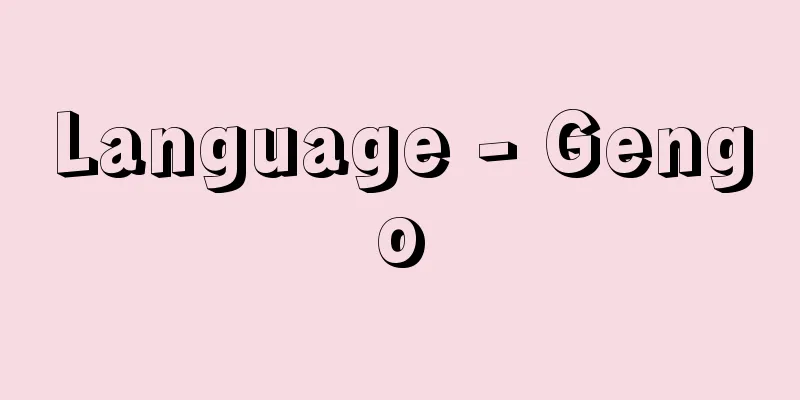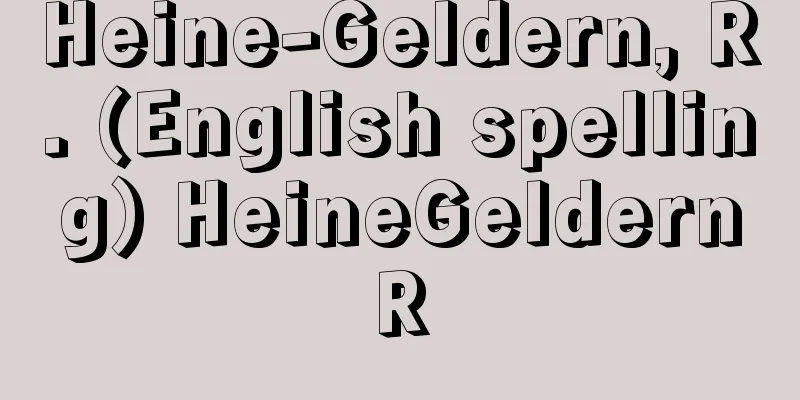Language - Gengo

|
The word "language" is multi-sense. It can refer to a system of vocabulary and grammatical rules stored in the language center of the brain, or it can be understood as the ability to use that system. On the other hand, it can also refer to the linguistic ability shared by all humans in an abstract sense, or to an individual, separate language. [Tetsuya Kunihiro] DefinitionThe basic definition is usually of the language system shared by humans, which is "a system of symbols established by social custom that serves the function of conveying emotions, information, requests, etc., primarily through sound and secondarily through letters." When considered as a human ability, it can be further divided into two types. One is knowledge of the system, which consists of vocabulary knowledge and the ability to create and understand grammatical sentences. The other is the ability to use appropriate linguistic expressions in specific situations. If we explain these two types of ability using the metaphor of a car, knowing how to operate the engine, steering wheel, gears, accelerator, and brake corresponds to system knowledge, while knowing how to deal with traffic rules and road conditions corresponds to ability to use. Neither language nor cars can be used unless both abilities are present. Something produced by exercising linguistic ability is sometimes called language. The dance of bees and the cries of monkeys are sometimes referred to as "animal languages," but this is merely a metaphor and is quite different from human language. Both are symbols, but the following are characteristics that only human language symbols have: [1] There is no necessity for the connection between the sounds that make up a linguistic symbol and its meaning. In Japanese, the sound "baka" is associated with the meaning of "idiot," but in Spanish, it is associated with the meaning of "cow." This is called the arbitrariness of a linguistic symbol. [2] Most words are divided into smaller sound units (phonemes), so that a relatively small number of these sound units can be combined to form a large number of words, which can then be combined to form an almost infinite number of different sentences. This is called the "double articulation" of language. [3] Language elements such as phonetic units and words form a system based on their similarities and differences. The Japanese alphabet is one example. This is called the systematic nature of a language. [Tetsuya Kunihiro] Spoken and written languageLooking at languages around the world, there are languages that only have sounds and no writing, but not the other way around, and the same can be said for individuals. Therefore, the primary medium of language is sound. However, in special cases, such as some deaf and mute people, written language can be acquired without sounds. There is also sign language, although it is not exactly the same as normal language. Compared to written language, spoken language is strongly restricted in terms of reach and future preservation, but it has the advantage that it requires less effort, can use both hands, and can be used in the dark or with people who are not paying attention to it. Spoken language is originally used in face-to-face conversations, while observing the facial expressions, gestures, and posture of the other person. In this case, the information that can be conveyed visually is richer than expected. Care must be taken, as gestures and their meanings may differ depending on the language used. When communicating over the phone or in the dark, information cannot be conveyed visually, so tone of voice and choice of words must take over. When using written language, the parts that can be conveyed through tone of voice must also be changed to choice of words. Since the situational context that accompanies face-to-face conversations is missing, expressions in written language are much more complex than those used in face-to-face conversations, and the level of politeness in expression is usually greater. Generally, written languages are conservative, and the differences between them and spoken languages will widen over time if left unchecked. Therefore, sometimes it becomes necessary to bring them closer to spoken languages through the movement to unify spoken language and the modernization of kana spelling. [Tetsuya Kunihiro] Language FeaturesThe act of "utterance" is established when a speaker utters a sound in a specific situation, the sound is received by a listener, and the meaning the speaker intended to convey is understood. Linguistic expressions produced by speech acts are also sometimes called "utterances." While utterances convey literal meaning, they usually also fulfill other functions. These can be thought of as being divided into "utterance intentions" and "utterance effects." Examples of utterance intentions include the following: (Report) I returned from a trip yesterday. (Explanation) When you press this button, the door will open. (Belief) I believe that he is innocent. (Instructions) Please make a copy of this document. (request) (from a child to a parent) I want something to eat. (Offer) I'll help you when you move. (Promise) I will return this book within next month. (Deciding) I'm going to quit smoking starting today. (Question) What is this? (Doubt) I have some sort of strange feeling in my stomach. (Apology) I'm sorry. (Thank you) I'm sorry. (Permission) Please come in. When such speech intentions are understood by the listener, they often have a further influence on the listener's psychological state and behavior. At that point, a speech effect has occurred. If you say "sumimasen" to apologize in a crowded place and people move out of the way, the speech effect has occurred, but this effect does not always occur. Speech acts such as the one above can be seen as having a multi-layered structure, as shown in the diagram below.
The language functions we have discussed so far have been based on the transmission of some kind of semantic content, but equally important is the social function of language. People are socially connected through dialogue. As can be seen in greetings such as "hello," the function is fulfilled simply by exchanging words, even if there is no semantic content. Slang, artisan language, and technical terms are words that have semantic content but are difficult for ordinary people to understand. By exchanging these words, people belonging to a particular group confirm their friendship and strengthen their sense of camaraderie. This function is not limited to specific words, but also includes certain phrases and ways of pronunciation. It can be said that a text that uses unnecessarily difficult technical terms is one in which the writer's intention to express his or her expertise precedes the transmission of content. Language also has the function of being used as a tool for play. Examples include word chains, puns, palindromes, and riddles. Language also has the function of influencing physical conditions through suggestion. Examples include when a person suddenly becomes energetic after being told by a doctor that "it's nothing" or when someone falls into a hypnotic state. [Tetsuya Kunihiro] Language StructureA language is a complex of various kinds of structures. The system of phonetic units already mentioned is included in the broad sense of the word structure. The main parts of the system of consonant phonemes in standard Japanese are as follows:
When we broaden our view beyond a single sentence, we see dialogue structures, paragraph structures, novel structures, etc. These are collectively called "discourse structures." [Tetsuya Kunihiro] Continuous and discontinuous linguistic structuresThe structure of language is based on the oppositional relationship between discontinuous elements. However, language is not discontinuous throughout. In Japanese, which does not use word segments, the boundaries between words are sometimes unclear. Is "going out" one word, or are they two words, "going out" and "wearing"? For example, are Japanese words that have the same pronunciation but are assigned different kanji, such as "wake up" and "wake up," separate words, or is they a single, ambiguous word? There are also subtle intermediate stages in the appropriateness of word linkage. "Delicious rice" and "delicious rice" are fine, but "delicious rice" and "delicious rice" are a little strange. "Onaka ga Suku" and "Hara ga Haku" are fine, but what about "Onaka ga Haku" and "Hara ga Suku"? Some people may find them fine, while others may find them a little strange. [Tetsuya Kunihiro] Homogeneity and heterogeneity of linguistic structuresOne research methodology is one that strives to study language in its pure state, that is, in the same dialect and with the same writing style, based on the belief that in order to clarify the structure of language, it is necessary to prepare analytical materials that are as homogeneous as possible. However, in reality, even an individual may use a variety of writing styles, mix them together, or vary in usage for no apparent reason. It can also be said that no two people speak the exact same language, even within the same dialect region. The homogeneity of language is considered an analytical fiction, and separate research methods have been devised that statistically analyze variation and heterogeneity as they are. [Tetsuya Kunihiro] Language changeLanguage is constantly changing. The speed of change is not uniform, being influenced by the social situation at the time, and may also differ from language to language, but it has been observed that in many cases, the process of a change spreading throughout a language follows a pattern of being slow at the beginning, fast in the middle, and then slow again at the end. Possible causes of change include social factors such as fashion and the influence of foreign languages, physiological and psychological factors that seek economy of labor, and linguistic factors that attempt to correct imbalances in the language structure, but in many cases, a combination of factors work together. Change begins with some kind of trigger and spreads gradually from individual to individual and word to word, and is never completed all at once in a month or two. Before a change begins, the foundation for it is usually already in place within the language. For example, in recent years, the phenomenon of "rareru," which expresses both the passive and the possible, being differentiated into "rareru" (passive) and "reru" (possible) has become noticeable in standard Japanese, but it is thought that prior to this, speakers of dialects who distinguish between the two forms had been migrating to Tokyo for many years and gradually increasing in number. On the other hand, it may have been felt inconvenient in Tokyo to use "rareru" to express two different meanings. Traditionally, analogy has been considered one of the factors of change, which increases the uniformity of language and is labor-efficient. Some also believe that the cause of change lies in the incompleteness of children's language acquisition, but this is unlikely to be a strong cause, since it is normal for this to be corrected as children grow up. While change is in progress, old and new forms are used together. To ordinary people, this usually appears as "disorder," but it is a natural phenomenon that is always seen in language, and it is more appropriate to see it as simple "fluctuation." Language does not unilaterally "collapse" from its old complex state and move toward simplification, nor does it become increasingly "disordered" and fall into a state of chaos. It is believed to change in a direction that meets human needs, while maintaining a delicate balance between unity and differentiation. [Tetsuya Kunihiro] Language ContactWhen two languages come into contact in any way, various phenomena arise. [1] Vocabulary, expressions, etc. are borrowed. The meaning of the borrowed word usually remains part of the meaning of the original word or has been changed. [2] Individuals may become bilingual when they move to a different linguistic society. [3] Two groups who speak languages that they cannot understand each other may create a makeshift third language out of commercial necessity, in search of a means of communication. This third language has a very simple structure based on a civilized language such as English or French that is widespread in the region, and is called a "pidgin." When children who grew up listening to a pidgin adopt it as their mother tongue, the pidgin is said to have become creolized. Since a "creole" needs to be able to handle all aspects of daily life, it supplements it by adopting vocabulary and grammar from the base civilization, making it richer in structure than a pidgin. If this supplementation continues, it will become closer and closer to the base civilization, and as a result, the creole will disappear (decreolized). [Tetsuya Kunihiro] "Lectures on Language, 6 volumes: Volume 1: Structure of Language edited by Shibata Takeshi, Volume 2: Language Change edited by Ikegami Jiro, Volume 3: Language and Behavior edited by Minami Fujio, Volume 4: The Art of Language edited by Chino Eiichi, Volume 5: World Characters edited by Nishida Tatsuo, Volume 6: World Languages edited by Kitamura Hajime -- (1980-81, Taishukan Shoten)" [References] | | | | | | | |Source: Shogakukan Encyclopedia Nipponica About Encyclopedia Nipponica Information | Legend |
|
「言語」という語は多義である。大脳の言語中枢に蓄えられた語彙(ごい)と文法規則の体系をさすこともあり、その体系を用いる能力としてとらえることもある。一方では、抽象的に、すべての人間が共有する言語能力をさすこともあるし、個々の個別言語をさすこともある。 [国広哲弥] 定義基本的な定義としては、人間が共有する言語体系を取り上げるのが普通で、「一次的には音声、二次的には文字を用いて、感情・情報・要求などを伝える機能を果たす、社会習慣的に定められた記号の体系」ということになる。人間の能力としてとらえられた場合は、さらに2種類に分けられる。一つは体系の知識であり、語彙知識と、文法的な文をつくり、また理解する能力からなる。もう一つは、具体的な使用場面で適切な言語表現を用いることのできる使用能力である。この2種類の能力は、自動車の比喩(ひゆ)を用いて説明するならば、エンジン、ハンドル、ギア、アクセル、ブレーキの操作方法を知っているのが体系知識に相当し、交通規則、道路状況への対処の仕方を知っているのが使用能力に相当する。言語も自動車も、両方の能力がそろっていないと使うことができない。言語能力を行使して産出したものを言語とよぶこともある。 ミツバチのダンスやサルの鳴き声をさして「動物“言語”」とよぶことがあるが、これはあくまで比喩であって、人間言語とは大きく隔たっている。両方ともに記号であることには変わりはないが、人間言語の記号のみが有する特色として次のものがあげられる。 〔1〕言語記号を構成する音声と意味の結び付きには必然性がない。「バカ」という音声に、日本語では〈馬鹿(ばか)〉という意味が結び付けられているが、スペイン語では〈雌牛〉という意味が結び付けられている。これを言語記号の恣意(しい)性という。 〔2〕大部分の語はさらに小さい音声単位(=音素)に分割され、比較的に少数の音声単位を組み合わせることにより、多数の語をつくりだせるようになっている。この語をさらに組み合わせて、無限に近い数の異なった文をつくりだすことができる。これは言語の「二重分節性」とよばれる。 〔3〕音声単位、語などの言語要素は、それぞれ共通点と相異点に基づいて体系を構成している。日本語の五十音図はその一例である。これを言語の体系性という。 [国広哲弥] 音声言語と文字言語世界中の言語をみると、音声のみあって文字をもたない言語はあっても、その逆の場合はなく、一個人をとってみても同じことがいえる。したがって、言語の媒体は、一次的には音声ということになる。しかし、一部の聾唖(ろうあ)者のような特殊な場合には、音声抜きで文字言語が習得されることがある。また、普通の言語とまったく同じというわけではないが、手話もある。音声言語は、文字言語に比べて、その到達距離、将来への保存の点で強く制約されてはいるが、労力が少なくてすみ、かつ両手を使うことができ、暗い所や、注意をよそに向けている相手に対しても用いることができるという長所がある。 音声言語は、相手の表情・身ぶり・姿勢などを見ながら、対面対話の状態で用いられるのが本来の姿である。この場合、視覚的に伝えられる情報は予想以上に豊かである。言語が異なると、身ぶりやその意味が異なることがあるので、注意を要する。電話対話や暗闇(くらやみ)での対話では、視覚による情報伝達ができないので、声の調子やことば遣いで肩代りしなければならない。文字言語を用いる場合は、声の調子で伝えられる部分もことば遣いに変えなければならない。対面対話に付随する場面の状況も欠けているので、文字言語による表現は、対面対話で用いられる言語表現よりもはるかに複雑で、表現のていねい度もあがるのが普通である。 一般に文字言語は保守的であり、音声言語との差異は、放っておけば、時の流れとともに開いてゆく。そこで、言文一致運動とか、仮名遣いの現代化などによって、ときおり音声言語に近づける必要が生じる。 [国広哲弥] 言語の機能ある具体的な場面で話し手が音声を発し、それが聞き手によって受け取られ、話し手が伝えようとした意味が理解されたとき、「発話」という行為が成立する。発話行為によって産出された言語表現も「発話」とよばれることがある。発話は文字どおりの意味を伝えると同時に、別種の機能も果たすのが普通である。それは「発話意図」と「発話効果」に分けて考えることができる。発話意図としては、次のようなものがある。 (報告)きのう旅行から帰ってきました。 (説明)このボタンを押すと、戸が開きます。 (信念)あの人は潔白だと信じています。 (指示)この書類のコピーをつくってください。 (要求)〈子供が親に〉何か食べたい。 (申し出)お引っ越しのときは手伝いに行きます。 (約束)この本は来月中にお返しします。 (決心)今日からたばこをやめる。 (疑問)これは何だろうか。 (疑念)どうも胃の調子がおかしい。 (詫(わ)び)すみません。 (感謝)すみません。 (許可)どうぞお入りください。 このような発話意図が聞き手に理解されたとき、それはさらに聞き手の心理状態や行動に影響を及ぼすことが多い。そのとき発話効果が生じたことになる。人混みのなかで「すみません」と詫びの発話をし、人が道をあけてくれたら発話効果が生じたことになるが、効果がつねに生じるとは限らない。以上のような発話行為は、下図のような重層構造をなしているとみることができる。
これまで触れてきた言語機能は、なんらかの意味内容の伝達を基盤とするものであったが、それと並んで重要なのは言語の社会的機能である。人は対話を交わすことによって社会的に結び付けられる。「こんにちは」などの挨拶(あいさつ)にみられるように、意味内容はなくても、ことばを交わすだけでその機能は発揮される。隠語・職人語・専門語などは、意味内容はあるが、一般の人にはわかりにくい語である。これらの語を交わすことによって、特定のグループに属する人々は、仲間関係を確かめ、また仲間意識を強める。この機能を果たすのは、特定の語に限らず、ある言い回し、発音の仕方も含まれる。不必要に難解な専門語を用いた文章は、執筆者の専門家であることの表明意図が、内容伝達に先行するものであるといえよう。 言語はまた遊びの道具としても用いられるという機能をもっている。例としては、しりとり、駄洒落(だじゃれ)、回文(かいぶん)、謎(なぞ)などがある。 言語は、暗示によって身体状況に影響を及ぼす機能も有している。医者から「なんでもありません」といわれて急に元気になったり、催眠術にかかったりするのがその例である。 [国広哲弥] 言語の構造言語はさまざまな種類の構造の複合体である。すでに触れた音声単位の体系も、広義の構造のなかに含まれる。日本語共通語の、子音音素の体系の主要部分は次のようになっている。
一つの文以上に視野を広げると、対話の構造、段落の構造、小説の構造などがみえてくる。これらはまとめて「談話discourse構造」とよばれる。 [国広哲弥] 言語構造の連続と非連続言語の構造は、非連続的な要素の対立関係のうえに成り立っている。しかし、言語の隅々まで非連続的であるわけではない。分かち書きをしない日本語では、語と語の切れ目がはっきりしないことがある。「外出着」は一語であろうか、「外出」「着」の二語であろうか。発音が同じでも異なった漢字をあてる和語、たとえば「覚める」と「醒(さ)める」は別々の語であろうか、それとも多義的な一語であろうか。語の連結の仕方の適切さの場合も、微妙な中間段階がある。「おいしい‐ごはん」「うまい‐めし」はいいが、「うまい‐ごはん」「おいしい‐めし」はすこしおかしい。「おなかがすく」「はらがへる」はいいが、「おなかがへる」「はらがすく」はどうか。いいようでもあるし、すこしおかしいと感じる人もあろう。 [国広哲弥] 言語構造の等質性と異質性言語の構造を明らかにするには、分析資料をできるだけ等質的に整える必要があると考えて、同一方言の同一の文体で用いられる言語という純粋な状態を対象とすることに努力を払う一つの研究法がある。しかし、現実には、一個人をとってみても、場合によって、さまざまな文体を使い分けたり、混用したり、また理由もなく用法がゆれたりする。また、同一の方言地域内でも、まったく同じ言語をもっている人は2人といないといえる。言語の等質性は一つの分析方法上の仮構と考え、別途にゆれや異質性をそのまま統計的に分析する研究法も考え出されている。 [国広哲弥] 言語変化言語はつねに変化している。変化の速度は一様ではなく、そのときの社会状況により左右され、また言語によっても異なりうるが、一つの変化が言語全体に行き渡る過程は、初めがゆっくりで、途中は早く、終わりはまたゆっくりになるという型をたどることが、多くの場合に観察されている。変化の原因としては、流行とか外国語の影響などの社会的なもの、労力の経済を求める生理的・心理的なもの、言語構造の不均衡を直そうとする言語的なものなどが考えられるが、多くの場合、複合的に作用する。変化は何かのきっかけによって始まり、個人から個人へ、語から語へと逐次に伝わってゆくのであり、けっしてひと月かふた月の間に一挙に完了するというものではない。変化が始まる前には、その素地が、すでに言語内に整っているのが普通である。たとえば、最近の日本語共通語では、受身と可能の両方を表す「られる」が、「られる」(受身)と「れる」(可能)に分化する現象が目だっているが、それ以前に、長年にわたって両形を区別する方言の話者が東京に移住してきて、徐々に数を増していたということが考えられる。一方では、東京で、「られる」を用いて二つの異なった意味を表すことの不便さも感じられていたということもあろう。 従来、類推は変化の要因の一つと考えられていたが、これは言語の均勢を増すとともに、労力経済にもかなうものである。幼児の言語習得の不完全さに変化の要因を求める考え方もあるが、幼児が成長するにつれて訂正されるのが普通であるから、有力な原因とはなりにくい。 変化の進行中は、旧形と新形が併用される。これは、一般の人には「乱れ」と映るのが普通であるが、言語につねにみられる自然な現象であり、単なる「ゆれ」とみるのが妥当であろう。言語は、一方的に昔の複雑な状態が「崩壊」して単純化に向かうわけでもなく、「乱れ」が進んで混沌(こんとん)状態に陥るわけでもない。統一と分化の微妙な均衡を保ちながら、人間の必要を満たす方向に変わってゆくものとみられる。 [国広哲弥] 言語の接触二つの言語がなんらかの形で接触した場合、いろいろの現象が生じる。 〔1〕語彙、表現法などが借入される。借入語の意味は、原語の意味の一部であったり、変化しているのが普通である。 〔2〕異言語社会に移住したりした場合、個人は二重言語話者となることがある。 〔3〕互いに通じない言語を話す二つのグループが、商業上の必要から、伝達手段を求め、まにあわせ的な第三の言語をつくりだすことがある。これは、その地域に広まっている英語・フランス語などの文明語を基盤とした、きわめて単純な構造をもつもので、「ピジン」pidginとよばれる。ピジンを聞いて育った子供たちがそれを母語としたとき、ピジンはクレオール化したという。「クレオール」creoleは、日常のすべての用を弁じる必要があるところから、基盤文明語から語彙や文法を取り入れて補強するので、構造はピジンに比べて豊かとなる。この補強がさらに進むと、基盤文明語にますます近づくことになり、結果としてクレオールは消滅する(decreolized)。 [国広哲弥] 『『講座 言語』全6巻――柴田武編『第1巻 言語の構造』、池上二良編『第2巻 言語の変化』、南不二男編『第3巻 言語と行動』、千野栄一編『第4巻 言語の芸術』、西田龍雄編『第5巻 世界の文字』、北村甫編『第6巻 世界の言語』――(1980~81・大修館書店)』 [参照項目] | | | | | | | |出典 小学館 日本大百科全書(ニッポニカ)日本大百科全書(ニッポニカ)について 情報 | 凡例 |
Recommend
Caucasus
…the region in southeastern Europe, between the B...
Nagano Ushikasegi - Nagano Ushikasegi
A packer from Nakamura Village, Chikuma County, Sh...
Rhodomela teres (English spelling) Rhodomelateres
…It is known to contain bromine compounds, and wa...
Braun, A.
…However, his definition of dicotyledons includes...
Public impeachments
A type of judicial procedure for the dismissal of ...
Accident insurance - shogaihoken
This is insurance that pays benefits when the ins...
Euphorbia milii (English spelling) Euphorbiamilii
… [Hiroshi Yuasa]. … *Some of the terminology tha...
Western
A type of action film (action drama). Originally ...
Adrenergic nerves
A general term for nerve fibers that release epine...
American Legion
…the American Legion. It was organized among sold...
Ming Confucianism Plan
The major work of Huang Zongxi, a thinker from th...
Khumbu Himal
…It is part of the Khumbu Himal mountain range, l...
Short wave - tanpa (English spelling) short wave
One of the names given to classify radio waves ac...
"Azuma Kagami" - Azuma Kagami
…Also written as Toukagami. A history book compil...
Cineclub - ciné-club (English spelling) French
An independent organization that regularly holds s...









